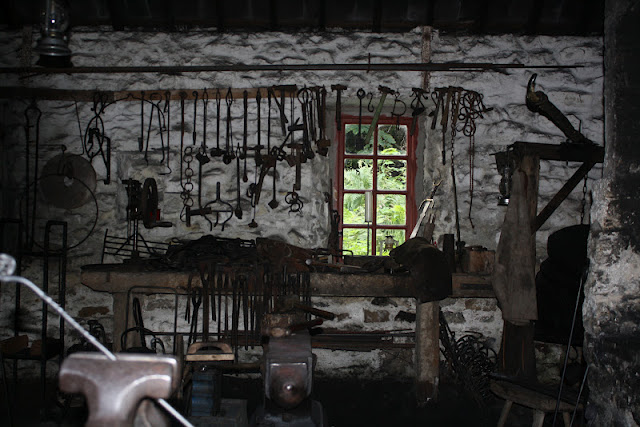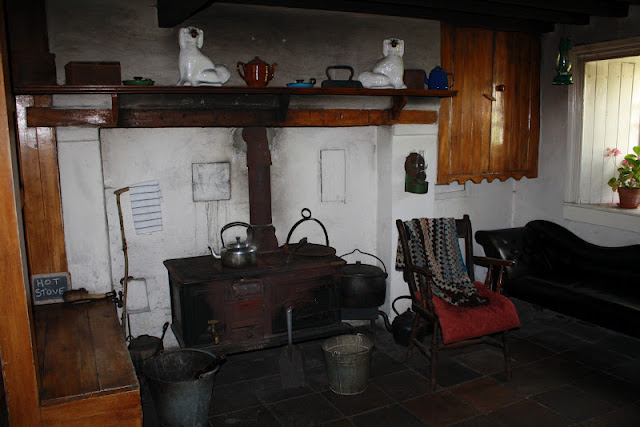Ballydugan Weaver's House
"This is a linen weaver's dwelling and workshop. Handloom weavers had to work long hours to produce sufficient cloth to earn a decent livelihood. An exhaustive record search shows that there was no land attached to this house, just a small garden, so weaving was the family's only source of income.Working conditions were uncomfortable - the earth floor in the weaving shop was necessary to maintain sufficient humidity in the air to prevent the linen threads drying out and breaking."
 |
| fireplace |
Tullylish Bleach Green Tower
 |
| Samuel and Sabrina in the tower |
"Two centuries ago this small distinctive stone tower provided shelter for a watchman. His duty was to guard the long rows of newly woven linen webs stretched and often pegged down upon the grass and left to bleach in the sun.
Older methods of bleaching linen involved various lengthy treatments of washing and boiling the cloth and included the placing the linen upon greens in the open air throughout the summer months.
A web of linen is a whole piece of cloth woven upon a loom. The linen webs were placed upon gentle slopes of a designated green or bleach field. The natural colour of unbleached linen is brown but over several weeks the effect of sunlight helped to bleach or whiten the linen cloth.
The green keeper who used the watch tower guarded the linen from damage; ‘linen on the green’, was vulnerable to damage from straying livestock and from theft.
During the 18th century stealing cloth from bleach greens was a common crime in Ulster as the stolen cloth was relatively easily sold. However, if the thief was caught the punishment was harsh. Penalties included the death sentence, a consequence which remained in force for this crime until the law was repealed in 1811.
The Tullylish watch tower was acquired by the museum in 1967 and re –erected in its present location. Originally it was one of a pair of watch towers which guarded the bleach green at Tullylish near Gilford in Co. Down in the 1800s."
There were no signs to tell us what this tower was used for. I had to come home and read about it. It is a lot more exciting now.
Lisrace Forge
"The local blacksmith was a craftsman of vital importance in both town and countryside. In an age dependent upon the horse for transport, the blacksmith was in constant demand for shoeing horses. He was also in demand for making and mending all manner of metal implements for use both in the home and on the farm. Practically nowhere in Ireland was more than seven miles from a blacksmith's forge such was their importance to daily life in general.
The Lisrace Forge was the workplace of three generations of the Wilson family. Thomas Wilson established the forge, in what originated as a dwelling, about 1850 when wrought iron had become relatively cheap and plentiful, and was succeeded in the business by his son, James, and his grandson, Robert.
The internal layout is typical of country forges. The principal features are the fire with its bellows and the anvil for working the hot metal. The water trough, or 'fizz' trough, for cooling the hot metal is close by - sudden cooling of hot metal hardened it. The anvil is set on a block of wood which absorbed some of the impact of the hammering and 'gave the anvil life'. This 'life' gave the hammer a degree of bounce every time it hit the metal being worked and protected the blacksmith from what is now called repetitive stress injury.
Original location: Lisrace townland, Magheraveeley, Newtownbutler, County Fermanagh"
 |
| Lisrace Forge |
 |
| blacksmith tools |
Ballydown National School
"Ireland's National School system was established in 1831 with the joint aims of making literate the mass of the population and of educating together children of all religious denominations. There was provision for separate religious education, outside normal school hours, by the various ministers of religion.By the early 1860s the interdenominational character of the National Schools had largely disappeared in the face of opposition from denominational church and clerical interests. This school was built in 1865 on land adjacent to and owned by Ballydown Presbyterian Church. As well as producing textbooks for use in schools, the Commissioners for National Education published a series of architectural plans for use by local groups receiving grant aid for school-building.
The Ballydown school was built to "Plan No. 3 - for 100 children on the rolls", a plan published in 1858. The desk accommodation seems minimal for 100 pupils but it would be only on rare occasions that all 100 children would be present because of illness, truancy, duties of work and other factors.
We should also consider that education was very regimented. At any time during the day, there would have been children standing at the front of the room reciting their lessons, or receiving instruction under the close supervision of the one and only teacher. The rest of the children required a lower level of supervision as they did such work as arithmetic or writing exercises in the desks
Original location: Ballydown townland, Banbridge, County Down."
 |
| Ballydown National School House |
 |
| first day of school |
 |
| teachers desk |
Hand and Pen Orange Hall
"The Orange Order, a Protestant religious/political society, was founded in 1795 at a time of heightened sectarian animosity and economic resentments. It was dedicated to sustaining the "glorious and immortal memory" of King William III and his victory over his father-in-law, King James II, at the Battle of the Boyne in 1690.At first the Order was both loyalist and intensely anti-unionist; it was associated with the bloody suppression of the 1798 Rebellion and, because of the prospect of Catholic Emancipation, with opposition to the Act of Union (1801).
With the changing character of Irish society and politics during the 19th century, and fearing Catholic domination in an independent Ireland, by 1900 the Order was in the forefront of opposition to Home Rule - the repeal of the Act of Union and the restoration of an independent Irish parliament.
The Order was mostly confined to Ulster and in the latter quarter of the 19th century when it experienced massive growth, Orange halls became a common feature in both town and countryside. This hall was built at Silverstream, in the heart of the Monaghan countryside, in 1884, although the associated Orange Lodge, Hand & Pen LOL 597, had been in existence from at least 1843. The reason for its curious name remains a mystery but it is thought to have originated from a local shop that had an illustrated sign featuring a hand writing in a ledger.
Original location: Silverstream, County Monaghan"
 |
| Hand and Pen Orange Hall |
Drumnahunshin Farm
"The Patterson family lived at Drumnahunshin from the 1830s when this house was built, until the 1960s, when the last occupant, Miss Maggie Patterson died. Miss Maggie's niece, Mrs Gay Patterson Komich of Hillsborough, California, inherited the property and presented it to the Museum.Originally the Pattersons were tenant farmers of the Earls of Gosford. In 1818 the farm comprised 30 acres (12.2 hectares) but with later sub-divisions it was reduced to 10 acres (4 hectares). Ownership passed to the family when the Land Reform Act (Wyndham's Land Act) of 1903 enabled tenants to buy the ownership of their farms.
Although the farm was of only 10 acres, it included a flax-scutching mill that provided the family with a considerable income. At different times the dwelling was substantially altered and improved.
The original single-storey house was raised to two stories, the kitchen was subdivided to create a separate dining room and the original ground floor bedroom became a parlour. Several features suggest a degree of affluence, the cast iron stove in the kitchen which replaced the original open hearth, the mock panelling in the parlour, the decorative fire surrounds and some fine furniture and china.
Original location: Drumnahunshin townland, Whitecross, County Armagh"
We spent considerable time talking to two gentlemen who were tour guide/actors in this house. It was very interesting to hear the history of the house first hand. The niece who inherited the house decided for family relations it would be best to donate it to a museum, then all the family members could visit it at their leisure. The Museum has held dinners in the house for the family when they visit from the USA.
The men also mentioned a phrase I had never heard before "money from America". Many families that immigrated to Canada or the USA would send money back to help the folks at home. It could change their lifestyle and make life easier. The one gentleman mentioned if he found a 20 pound note on the street he would still declare to his friends he had received "money from America". Money he didn't have to work for.
 |
| Drumnahunshin Farm house |
 |
| barns |
 |
| Samuel and a donkey |
 |
| Sarah and a horse |
 |
| Sabrina studying a chicken |
 |
| American made stove |
 |
| kids room |
 |
| parlor |


No comments:
Post a Comment